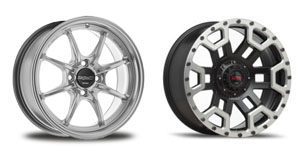Mag Rims

Alloy wheels or rims differ from steel-plated wheels in that they are made from aluminium or magnesium. Wheels are stronger, yet lighter, lowering the overall weight of the vehicle. They also conduct heat better, allowing for improved braking. One such benefit of using alloy wheels or rims is that it reduces the unsprung weight of the vehicle, resulting in improved cornering and reducing overall fuel consumption.
Additionally, wheels are very aesthetically pleasing and will improve the overall look of your car! Clean your wheels frequently to maintain the appealing look.
Why change to wheels?
- Wheels reduce the unsprung weight of a vehicle, giving you more controlled steering and reduced fuel consumption.
- Wheels are excellent conductors of heat, improving heat dissipation from the brakes and reducing the risk of brake failure under demanding driving conditions.
- Using the “Inch-up Principle” (increasing the diameter size of the wheel fitted by the manufacturers) when buying wheels, optimises steering response and road holding, especially when cornering.
- A set of wheels will make your car look great!
Conversions
The principle of conversion: The larger the wheel, the larger the tyre. This inversely lowers the tyre profile, because the original rolling radius of the car cannot be changed (rolling radius is the distance it takes for the wheel to make 1 complete revolution). In other words, if a car has a rolling radius of 2.050mm, after changing the wheels and tyres the radius needs to remain 2.050mm. The whole car from brakes, suspension and the gearbox is set up for this. If a change occurs the car will experience mechanical problems but more importantly features like ABS won’t work correctly. You could even have the speedometer indicating 120km/h but in reality you’re driving at 140km/h! Using this principle you can upgrade your wheels yet remain as close as possible to your original technical specifications. Never convert to a smaller size than the original fitted on your car.
Increasing your wheel size gives you 3 advantages:
- Optical: The look of the car improves immediately – makes it more attractive!
- Security: Braking distance can be reduced by up to 7% (3m) due to the larger sized wheel and wider tyre.
- Driving improvement: With a larger wheel and of course a lower tyre profile the car becomes more stable.
Choosing the correct wheel
- The wheel must complement your type of car (design, colour etc.)
- The wheel must be manufactured to fit properly.
Ask one of our Hi-Q professionals to advise you – they are experts in the field.


